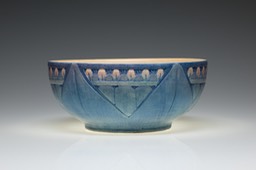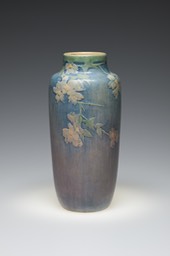Ceramic artist Tori Arpad-Cotta and curator Whitney Robertson discuss the exhibition's technical features and historical significance.
Wolfsonian exhibit explores the artistry and social implications of the Newcomb Pottery Enterprise
“All handwork is not necessarily good, but all good work is handwork.” So wrote Ellsworth Woodward, founding director of the Newcomb College art program in New Orleans. In 1885, a progressive educational experiment, the H. Sophie Newcomb Memorial College began there in association with Tulane University. It was the first women’s college at a previously all-male university in the United States, and the work created in its studio is the subject of an exhibition at the Wolfsonian-FIU.
Women, Art, and Social Change: The Newcomb Pottery Enterprise provides glowing examples of ceramics and related decorative artworks that explore enduring social and design issues. In doing so, it showcases the Wolfsonian’s mission of connecting politics and people to the objects they inspire and produce, with emphasis on the period from 1875 to 1945.
The commercial viability of Newcomb Pottery proved a mixed success. For the museum, that’s beside the point. The work itself, captivating if not groundbreaking, carries the mark of a significant social experiment. Cathy Leff, the Wolfsonian’s former director, is a Newcomb alumna. She saw the exhibition last year and recognized “it’s a perfect fit” for the Wolfsonian. Curator Whitney Richardson oversaw its local configuration.
Richardson explained that about a decade after Newcomb first opened, program officials “saw the success of their art students and thought, ‘We could make this into a profitable enterprise for the women.’” Much like today, the turn of the 19th century was a period of rapid growth, technological advancement and wealth disparity. The Arts and Crafts Movement originated in England as a counterpoint to the dehumanizing Industrial Revolution, which had mechanized much of European and American labor force activity in the interest of product standardization and profitability.
The dignity of handwork was central to this movement — and vital to the formation of the pottery studio within Newcomb College. In contrast to industrialized decorative arts production, in which each worker had an assigned role such as forming handles or painting roses, the Arts and Crafts model gave each designer-artisan ownership of the process from sketch to final polish. Each work carried the mark of its maker —– both stylistically and with a signature or stamp.
One of the Arts and Crafts movement’s founders was art critic and social philosopher John Ruskin, who advocated artistic training for artisans and hands-on training for designers. This bridge between mind and hand was central to the Newcomb art program, which emphasized a pairing of utility and beauty in multiple artforms.
Contemporary potteries and art tile works like Cambridge, Grueby, Rookwood, Muresque, Malibu and Teco produced ceramic ware of comparable sophistication. Their designs ranged from Moorish geometrics to historical scenes, portraiture to medieval revivals and Victoriana. Newcomb was distinctive in its focus on regional design.
Early on, Newcomb studio managers decided to focus their design vocabulary on flora and fauna of the American South. Regional plants and animals are readily apparent both in sketches and in the finished artworks. Here in South Florida, the Queen Anne’s lace, oak, pine, cypress, dragonfly, frog, blue crab, Spanish moss, Dutchman’s pipe, crêpe myrtle and ginger plant are all familiar — if not native.
The traveling exhibition, organized by the Newcomb Art Gallery in collaboration with the Smithsonian Institute’s Traveling Exhibition Service (SITES), also features jewelry, metalwork, needlework, linoleum prints and bookbinding. A lavish and scholarly catalog complements the ample wall texts and typically elegant presentation in the sixth-floor galleries.
The Wolfsonian has contributed a fine audio guide, collateral programming and its own American Arts and Crafts-style artisan display tables. The Wolfsonian also provides access to its permanent collection with myriad examples of kindred pieces — primarily from Europe.
“Despite the name, they did a lot more than just pottery,” said Richardson.
One of the Newcomb program’s first instructors, Gertrude Roberts Smith, was a respected painter; she connected painting with needlework, which became the second medium in the art curriculum. Newcomb embroidery is esteemed, but less for virtuosic stitchery than for the sophisticated color mixing of the pink, pale blue, yellow, green and creamy silk threads, anchored with dusky rose and burgundy. These are applied with darning and running stitches, mostly to buff-colored linen, often creating a pointillist optical mixing effect. The landscape designs of Alixia Bettison and Helen DeGrange’s vibrant Maiden and Macaw are certainly worth searching out. While motifs were repeated, each individual Newcomb piece was unique.
Newcomb Pottery was a business run primarily by women. Archival photographs show the women at work. One is hammering a silver bowl; others glaze pottery or gather to embroider. The settings suggest an intimate, collaborative spirit of work, so unlike industrialized production. Also evident is that this was a genteel — and white — workforce.
Ironically, this was a time and place where handwork was notably found in the region’s cotton fields, where low-paid, mostly African-American workers generated the wealth that underlay such experiments as Newcomb. “That’s something that’s only briefly touched on in the exhibit, but I think it’s an important point,” said Richardson. The women at Newcomb College and then at Newcomb Pottery were primarily well-off white women from New Orleans in a time when segregation was a foregone conclusion.
Still, the emphasis on developing marketable skills and self-reliance was remarkable, contradicting the stereotype of a Southern belle dependent on her man and confined to domestic responsibilities. “Moreover,” said Richardson, “unlike a job at the glove counter at the department store, for example, this was an artist’s realm, where they could work as a community of women, making this artwork.”
Notably, this was the post-bellum period, and the South was readjusting financially and socially. This was also the era of the suffrage movement, through which women were gradually gaining sovereign rights.
In 1900, Newcomb Pottery won a bronze medal at the Paris Exposition (the medal is on display), which enhanced the program’s profile and sales. The artisans were able to separate from the art department at the college and build their own warehouse, kiln room, sales room and studios. This benefited the women financially, too, although wages remained lower than forecast in promotions designed to solicit new recruits. Many women engaged in graphic design, writing and other freelance work on the side.
While the relative consistency of colors, materials and decorative motifs provided a recognizable Newcomb studio “brand,” it could also be artistically stifling. One prominent artist, Sarah “Sadie” Irvine, complained of ever having designed the popular “Moon and Moss” motif, because she and others had to do so many variations on it. For some, side work provided greater opportunities for invention.
Though Newcomb was a women’s enterprise, it involved gender roles that remained fairly rigid. It was the male potters who “dug the clay, prepared the clay and would mostly throw the pots on a potter’s wheel,” Miami artist and FIU instructor Tori Arpad-Cotta said during a curatorial tour.
Those pots when they were stiff enough would be returned to the women, who would apply the decoration to the surface. The men would then fire them.
At first, so-called slip glazes (clay mixed with water and mineral pigments) were applied directly onto the pottery. Early examples follow the familiar cobalt blue-on-white of Delftware with a high gloss finish. Then, along with the shift to a regionally based design aesthetic, the glaze technique progressed to incising shallow outlines between glaze colors (think of paint-by-numbers), and then to creating low relief surfaces on the leather-hard clay. Washes of color would pool in the low areas and thin out over the higher features of the design, emphasizing the relief forms.
Majestic oak trees, dripping with Spanish moss (visible right on campus), thick forests and proud pines — often with a moon peeking out — were especially popular. A charming mug by Amelie Roman affectingly depicts a forest floor, sheltering rabbits. Creating an illusion of deep space was challenging on the curved surface of a narrow vase, compared to a tile or embroidered cloth.
It’s instructive to see art class drawings — a Queen Anne’s lace, for example — next to a more stylized version that became the pattern for incising and glazing on a pot. As Arpad-Cotta noted, some of the more skilled artists could draw and glaze freehand, without the need for a paper stencil to assure a graceful and even layout. This was especially tricky when an uneven number of motifs would be applied.
The range of ceramic forms included in the Wolfsonian show includes humidors, tankards, pitchers, teapots, cups, saucers, plates, vases of every shape, inkwells, bowls and even tygs (multi-handled drinking vessels) — each presenting its own challenge to “wrap” with a design. Through numerous glaze experiments in the studio and showroom sales, a combination of blue and green with pale yellow-orange highlights assumed prominence. Art Deco’s popularity led to designs that were more stylized than highly representational. Still, nature motifs remain the Newcomb signature, even when quite abstract.
Unfortunately, the long hours needed to produce each piece proved economically unsustainable. “By 1940,” said Richardson, “we were an industrialized country and everything was mass-produced.” Following eight final years of focus on more utilitarian wares, the shop closed.
The Wolfsonian’s engaging audio guide features Irvine, whose Newcomb career spanned four decades, as the central figure. She is represented in various mediums, illustrating Newcomb’s themes and history. Irvine continued to make and sell ceramics after the close of the Newcomb ottery. “She finally ventured off from that flora and fauna motif but still used the South,” said Richardson. “There’s one plate called ‘Gulfstream’; it’s this beautiful turquoise platter, and it has a swirl design on the top of the plate to sort of evoke the idea of the water swirling in the Gulf. And it’s still very Southern. It’s still looking to that past of Newcomb Pottery, but she has taken it in a new direction to be abstract.”
Read more here: http://www.miamiherald.com/entertainment/visual-arts/article28718845.html#storylink=cpy

